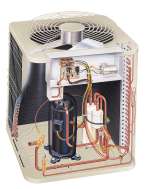Search engine visitors - click here to access entire "$ensible Home" web site
Click here to see a descriptive illustration of several new heat pumps and a complete comfort system.
Dear Jim: I want to install the most efficient heat pump for lower electric bills. I am also concerned about getting one which provides the best year-round comfort. What features should I look for in a new heat pump? - Bob M.

A: With the new minimum energy efficiency requirements for 2009, there have been improvements in heat pumps which make them an excellent choice for almost any home. The prices of fossil fuels, such as natural gas, oil and propane, are at record highs, so using a heat pump may be the least expensive source of year-round heating and cooling.
Heat pump efficiency in the cooling mode is rated by SEER (seasonal energy efficiency rating) similar to a central air conditioner. In the heating mode, the efficiency is rated by the HSPF (heating seasonal performance factor). Generally, the ones which are most efficient at cooling your home are also the most efficient when heating. If you now have an old heat pump with a SEER in the 8.0 range, installing one of the most efficient (SEER of 19) new ones can cut your utility bills by more than 50 percent.
Many of the HVAC (heating, ventilation, air-conditioning) manufacturers are starting to recommend hybrid heating, even in colder northern climates. Hybrid heating refers to installing a heat pump, instead of just a central air conditioner, along with a fossil fuel furnace.
During mild weather, the heat pump can be less expensive to operate than even the most efficient fossil fuel furnace. When the outdoor temperature drops, the furnace takes over. A heat pump of the same capacity, efficiency and features may cost only about $400 to $500 more than the equivalent (cooling only) central air conditioner.
As a brief background, a heat pump is basically a central air conditioner with a reversing valve. When switching from the cooling to the heating mode, the reversing valve reverses the direction of the refrigerant. The hot gases flow through the indoor blower coil to heat the air inside your home. The wall thermostat takes care of automatically switching the reversing valve depending upon whether you need heating or cooling.
A two-stage heat pump is your most efficient option and it also provides the best comfort. The heat pump has two different output levels when heating and when cooling. This allows the heat pump to be sized to handle some of the coldest or hottest days, yet also be effective during milder weather. Depending upon the compressor design, the heat pump lower-output level will be from 50 percent to 67 percent of the maximum higher-output level. A third stage is the backup electric resistance, oil or gas furnace.
This is great advantage because the heat pump runs in longer, more efficient cycles when it is operating in the lower-output level. Even though it is running longer, the compressor is using less electricity in this lower-output level so the overall electricity usage is reduced. By running longer and slower, there is less indoor blower and air flow sound and indoor temperatures remain more constant.
The majority of the HVAC manufacturers have switched to using a two-stage scroll compressor with R410A refrigerant instead of R-22 (commonly called Freon). R410A is much more environmentally friendly than R-22 and it operates at slightly higher pressures.
This requires more stout tubing, so the noise level from the outdoor unit is less noticeable. By the 2010, manufacturers will no longer be allowed to produce units using R-22.
Over the past several years, there has been quite a design push to make the outdoor unit run more quietly. This is accomplished by insulating the compressor motors, using more sound-damping mounts and redesigning the fins, fan blades and housing for quieter air flow. Most of the manufacturers can provide you with sound level ratings for their various models. Sound level does vary by size and compressor type.
Most two-stage heat pumps use a General Electric variable-speed ECM blower motor in the indoor air handler. This efficient motor varies its speed depending upon in the heat pump stage currently running and the air flow resistance in the ductwork. Heat pump efficiency and indoor comfort depends upon matching the outdoor unit, the indoor coil and the blower speed (air flow).
One of the key advantages of the variable-speed blower, when used with the proper thermostat, is in controlling the indoor humidity level. This impacts comfort and common allergens such as mold spores and dust mites. By varying the indoor air flow, the ratio of cooling to dehumidification can be controlled. This is ideal for humid climates.
Instant Download Update Bulletin No. 763 - 2009 buyer's guide of the 21 most efficient, comfortable heat pumps, capacities, compressor types, output levels, blower speeds, efficiencies (HSPF and SEER), warranties, illustration and description of how a scroll compressor works, heat pump maintenance suggestions and a savings/payback chart.
Dear Jim: My garage door opener motor seems to be struggling to open the garage door. It is noisy and seems to vibrate a lot. It has those tightly wound springs. Should I tighten them more to help lift the door? - Ed R.
A: The springs you are referring to are counterbalance torsion springs. They may have relaxed over time which causes the opener motor to work harder to open the door.
First make sure all the mounting bolts are tight. Trying to tighten those torsion springs yourself can be dangerous. If one comes loose while you have a rod in it, the rod can break your arm. Call a professional serviceman check it for you.